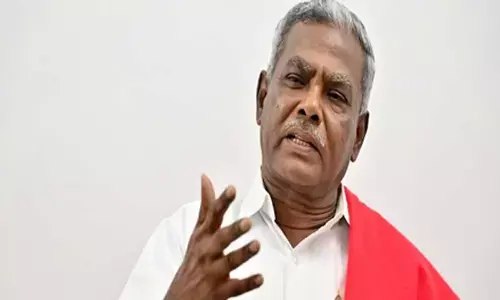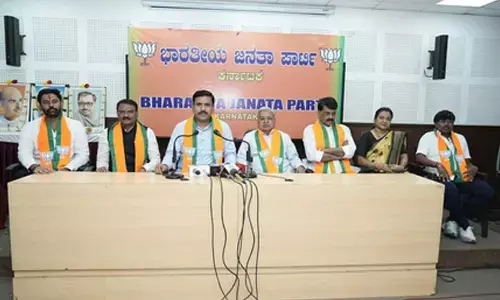NITI Aayog’s Draft National Energy Policy

The NITI Aayog’s Draft National Energy Policy (DNEP) predicts that between now and 2040, there will be a quantum leap in the uptake of renewable energy together with a drastic reduction in fossil fuel energy intensity.
The NITI Aayog’s Draft National Energy Policy (DNEP) predicts that between now and 2040, there will be a quantum leap in the uptake of renewable energy together with a drastic reduction in fossil fuel energy intensity.
What is the new policy about?
S NITI Aayog’s Draft National Energy Policy (DNEP), which was finally unveiled in June for public comments.
S The four key objectives of the new energy policy are ensuring access at affordable prices, improving energy security & reducing dependence on fossil fuels, Promoting greater sustainability & renewable energy & Ensuring sustained economic growth.
What are the notable points in the draft?
S It foresees India’s power demand shooting up over four-fold.
S The draft policy has made a case for higher tax on big cars, SUVs and promotion of mass transport system like metro rail to improve air quality.
S The renewable energy mix by 2022 is targeted at 175 GW.
S There has been a mention on phasing out IC engine vehicles but not much emphasis has been given.
S Because of economic and population growth, India’s annual per-capita electricity consumption is expected to triple, from 1075 kWh in 2015-16 to over 2900 kWh in 2040.
S The DNEP assumes 100% electrification throughout India in the near term and steadily improving energy efficiency.
S However, in addition to DNEP guidelines several critical issues involved in the on-going energy transition need to be taken into consideration.
S Energy is acknowledged as a key input towards raising the standard of living of citizens of any country, as is evident from the correlation between per capita electricity consumption and Human Development Index (HDI).
S Accordingly, energy policies of India have over the years directly aimed to raise per capita energy consumption, even while the main focus of the country’s development agenda has been on eradication of poverty.
S While India strives to achieve a double digit growth rate in its national income, it is equally important that clean energy is available to all the citizens.
S The NEP draft comes at a time when the energy sector is seeking clarity. In the face of claims of surplus power, even as rampant energy poverty continues to plague the country, the sector needs clear signals of the future pathways.
What is the aim of National Energy Policy?
S The intention of the National Energy Policy is to present a broad framework for the overall energy sector, taking into account the multiple technology and fuel options.
S The National Energy Policy (NEP) aims to chart the way forward to meet the Government’s following bold announcements in the energy domain.
S All the Census villages are planned to be electrified by 2018, and universal electrification is to be achieved, with 24×7 electricity by 2022.
S The share of manufacturing in our GDP is to go up to 25% from the present level of 16%, while the Ministry of Petroleum is targeting reduction of oil imports by 10% from 2014-15 levels, both by 2022.
S INDC (Intended Nationally Determined Contributions) target at reduction of emissions intensity by 33 percent-35 percent by 2030 over 2005.
S Achieving a 175 GW renewable energy capacity by 2022, and share of non-fossil fuel based capacity in the electricity mix is aimed at above 40% by 2030.
S In the light of the energy challenges faced by the country, and the global energy related developments, the NEP proposes to set out the national energy objectives and the strategy to meet them. There are four key objectives of National Energy Policy. However, these four goals may or may not move in harmony with one another.
S Access at affordable prices,
S Improved security and Independence
S Greater Sustainability and
S Economic Growth.
S While steps have already been taken by the Government to embed many such developments in the sectoral energy policies, however, it is desirable to develop a clear roadmap so that there is clarity amongst all the stakeholders on the Government’s long-term energy agenda.
Key takeaways from the draft
S NITI Aayog’s National Energy Policy is aimed at curbing imports by increasing production of renewable energy in the country fivefold to 300 billion units by 2019 and tripling coal production to 1.5 billion tonnes.
S Coal imports are envisaged to come down by 10% by 2022 and by 50% by 2030.
S This policy will replace the Integrated Energy Policy of the previous government.
S Coal Ministry opposes NITI Aayog’s Draft Energy Policy.
S Policy’s focus
S Policy focus on clean energy resources such as solar and natural gas
S Policy will also look at ways to improve the quality of air which has deteriorated significantly over the past years
S NITI aayog also plans to set up the National Energy Data Agency on the lines of the US Energy Information Administration (EIA).
S Agency will aim to provide oil and gas mapping by working with the Directorate General of Hydrocarbons, transmission line mapping, energy demand mapping and solar irradiation mapping, among others.
Issues with the draft regarding Coal Energy
S Despite the fact that existing coal plants are running at low efficiencies, the DNEP relies on coal power to sustain the nation’s base load requirement to meet rising energy demand.
S It proposes that coal will fuel 67% of India’s power generation in 2022.
S The first anomaly is that while India claims it will make a big push for renewables, it will continue to rely on coal for its base load generation.
S This is in direct conflict with the declared twin goals of sustainability and comes ironically at a time when solar and wind tariffs appear to be reaching historic new lows.
S The NITI Aayog also forecasts that “’our coal industry will emerge as an exporter of coal” in the backdrop of the shocking drop in demand for coal from most industrialized.
S The DNEP does not say what would be the fate of new allottees of coal mines which have bid aggressively and won rights to mine coal for captive power generation.
S Generation of power is licence free under the Electricity Act of 2003, so private miners do not need any licence to set up generating plants.
S All they need is a connection to the grid. Since the grid is State-owned, the Central government has adequate leverage to defer or delay connections.
S In the past three years, with slow industrial growth, independent coal producers have been faced with reduced demand for their power. Power plants, both public and private, have been running at merely 60% plant load capacity utilization.
S The conventional power industry already suffers a high level of bank loan defaults, insolvency and other legal proceedings.
S It is not surprising that new energy investors are crowding the nascent solar space.
Why is the policy more concentrating on coal?
S The DNEP is relying on coal power to sustain the nation’s base load requirement to meet rising energy demand. It proposes that coal will fuel 67% of India’s power generation in 2022.
S The first step is that while India claims it will make a big push for renewables, it will continue to rely on coal for its baseload generation.
S The second step is that even with this target, India will need only 741 million tonnes of coal in 2022 and 876 million tonnes in 2027. But the Ministry of Coal continues to push its ambitious targets to raise coal production to 1.5 billion tonnes by 2020, of which 500 million tonnes is expected to be produced by private coal mines and about 1 billion tonne by the public sector.
What are the hurdles?
S Power plants, both public and private, have been running at merely 60% plant load capacity utilization.
S Coal producers had to wait for a nod from the ministries of coal and power for support. Such support may not be forthcoming.
S The power industry already suffers a high level of bank loan defaults, insolvency and other legal proceedings.
What are the subject of importance?
S The DNEP has acknowledged that India’s oil consumption has grown 63% from 2005 to 2016 whereas the refining capacity has grown only by 15%.
S Gas consumption has increased by 38% while production has actually fallen since 2012.
S India’s energy security does require a large strategic storage of oil to take care of any vagaries in its international supply chain.
S The peaking of India’s oil demand could have been envisaged but has not been identified in the DNEP.
S On the one hand, the draft policy recognizes that by 2040, India’s oil import dependence may reach 55% from the current level of 33%. On the other hand, it offers nothing to curtail such dependence.
India Vision 2040
S The NEP aims at supporting the Indian ambition to emerge as a well-developed and resilient economy with high level of human development.
S Additionally, it helps prepare the nation to anticipate the technological and market related changes in the energy sector.
What will India’s energy sector look like in 2040?
S India Vision 2040 aims to answer the above precise question.
S Demand-driven provision of energy at affordable prices, high per capita consumption of electricity and access to clean cooking energy and electricity with universal coverage, low emission and security of supply will characterize the energy parameters of India in 2040.
S The energy mix will also undergo a transformation with preponderance of renewable technologies, storage solutions, smart grids and enlightened consumer behaviour becoming the order of the day.
S It presents the NITI Ambition Scenario (NAS) 2040 — energy in India in 2040 — the expected energy status of India, via the NEP.
S The NAS has been developed so as to provide a range of implications for the Indian energy sector.
S The range represents the outcome scenarios if India were to follow a business-as-usual path versus if it were to transition to an ambitious one — cleaner and more sustainable pathway.
S The policy mandate has to be linked to the latter.
Energy security
S The energy mix of India will have a high share of renewable which will sustain the present self-dependence scenario.
S India had imported nearly 31percent of its primary energy in 2012, with 77 percent and 22 percent of oil and gas imports, respectively.



















